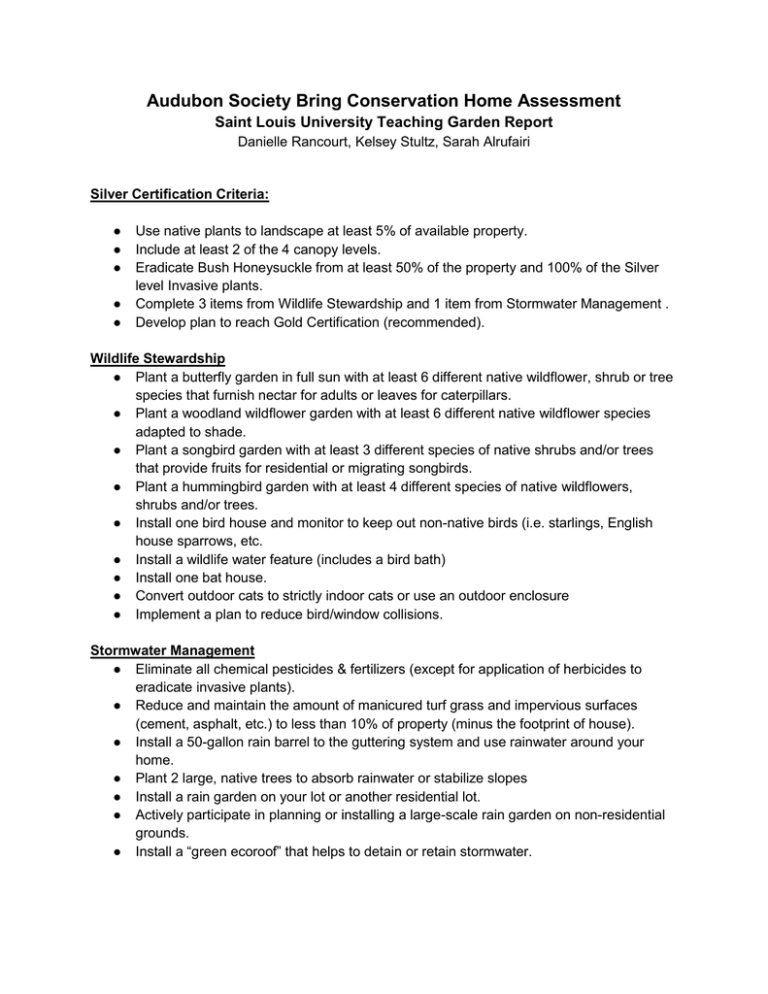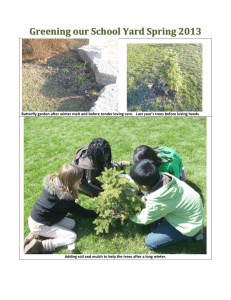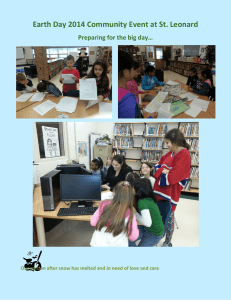Audubon Society Bring Conservation Home Assessment
advertisement

Audubon Society Bring Conservation Home Assessment Saint Louis University Teaching Garden Report Danielle Rancourt, Kelsey Stultz, Sarah Alrufairi Silver Certification Criteria: ● ● ● ● ● Use native plants to landscape at least 5% of available property. Include at least 2 of the 4 canopy levels. Eradicate Bush Honeysuckle from at least 50% of the property and 100% of the Silver level Invasive plants. Complete 3 items from Wildlife Stewardship and 1 item from Stormwater Management . Develop plan to reach Gold Certification (recommended). Wildlife Stewardship ● Plant a butterfly garden in full sun with at least 6 different native wildflower, shrub or tree species that furnish nectar for adults or leaves for caterpillars. ● Plant a woodland wildflower garden with at least 6 different native wildflower species adapted to shade. ● Plant a songbird garden with at least 3 different species of native shrubs and/or trees that provide fruits for residential or migrating songbirds. ● Plant a hummingbird garden with at least 4 different species of native wildflowers, shrubs and/or trees. ● Install one bird house and monitor to keep out non-native birds (i.e. starlings, English house sparrows, etc. ● Install a wildlife water feature (includes a bird bath) ● Install one bat house. ● Convert outdoor cats to strictly indoor cats or use an outdoor enclosure ● Implement a plan to reduce bird/window collisions. Stormwater Management ● Eliminate all chemical pesticides & fertilizers (except for application of herbicides to eradicate invasive plants). ● Reduce and maintain the amount of manicured turf grass and impervious surfaces (cement, asphalt, etc.) to less than 10% of property (minus the footprint of house). ● Install a 50-gallon rain barrel to the guttering system and use rainwater around your home. ● Plant 2 large, native trees to absorb rainwater or stabilize slopes ● Install a rain garden on your lot or another residential lot. ● Actively participate in planning or installing a large-scale rain garden on non-residential grounds. ● Install a “green ecoroof” that helps to detain or retain stormwater. Audubon Society Bring Conservation Home Report Summary of the Recommendations The site evaluation report of Audubon Society Bring Conservation Home involves many recommendations to establish native habitat in the St. Louis University Teaching Garden. These recommendations include the following: · · · · · · Suggest non-native invasive plants. Suggest plants for garden border outside the fence and within the garden. Create a wildlife water feature Suggest a butterfly garden Build nest boxes to attract birds. Build bee boxes. Based on the Silver certification criteria (see above) and the site evaluation recommendations, the next step to move SLU’s Teaching Garden closer to achieving Silver certification is by completing 3 projects from Wildlife Stewardship: ● ● ● · Plant a butterfly garden in full sun with at least 6 different native wildflower, shrub or tree species that furnish nectar for adults or leaves for caterpillars. Install one birdhouse and monitor to keep out non-native birds (i.e. starlings, English house sparrows, etc. Install a wildlife water feature (includes a bird bath) A plan for the butterfly garden: Incorporating native plants that serve the needs of all life stages of the butterfly and can thrive in weather conditions. For spring flowering: Bee Balm (Monarda bradburiana), Prairie Blue-eyed Grass (Sisyrinchium campestre), Prairie Coreopsis (Coreopsis palmata), Sand Phlox (Phlox bifida) and Thread-leaf Blue Star (Amsonia ciliata) Summer flowering: Bottlebrush Blazing Star (Liatris mucronata), Butterfly Milkweed (Asclepias tuberosa), False Aloe (Manfreda virginica), Glade Coneflower (Echinacea simulata), Missouri Coneflower (Rudbeckia missouriensis), Purple Prairie Clover (Dalea purpurea), Purple Poppy Mallow (Callirhoeinvolucrata) or Slender Mountain Mint (Pycanthemum tenuifolium) Fall flowering: Aromatic or Sky Blue Aster (Aster oblongifolius or oolentangiensis), Blue Sage (Salvia azurea), Fall Glade Onion (Allium stellatum), Gray Goldenrod (Solidago nemoralis) and Fall Glade Onion (Allium stellatum) Multi-season flowering: Fame Flower (Talinum calycinum), Harebell (Campanula rotundifolia), Rose Verbena (Glandularia canadensis) and Calamint (Calamintha arkansana) A plan for building a birdhouse: Select boxes incorporate features preferred by a particular bird species. Small nesting boxes are preferred for birds such as Carolina and House Wren, Tufted Titmouse and White-breasted Nuthatch. Open area for nesting is preferred for Bluebirds and the adjacent grounds. To build birdhouses: The Missouri Department of Conservation provide information on how to build your own birdhouses http://mdc.mo.gov/discover-nature/outdoor-recreation/woodworking A plan for a water feature in the Herb/Prayer Garden Suggest an inexpensive water feature called a pondless bubbler. https://www.youtube.com/watch?v=wKGD5Dq7Ljk Resources: http://www.stlouisaudubon.org/conservation/BCH/index.php




